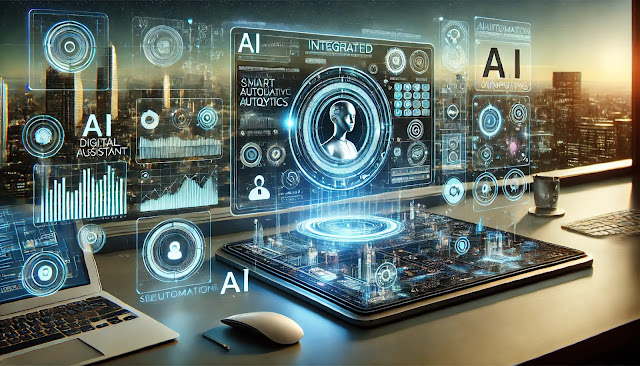Operating systems (OS) are the backbone of modern computing, enabling devices to function efficiently. As technology advances, operating systems continue to evolve with enhanced security, AI integration, and cloud-based computing. Let’s explore the latest trends and innovations shaping the future of OS.
1. AI-Integrated Operating Systems
Modern OS platforms are increasingly leveraging artificial intelligence to optimize performance. AI-powered assistants like Microsoft’s Copilot and Apple’s Siri are becoming deeply integrated, offering predictive actions, automated troubleshooting, and smart resource allocation to improve user experience.
AI integration in operating systems is already underway, with features like voice assistants, AI-powered search, and system optimization available in Windows 11, macOS, and Linux distributions. Microsoft and Apple continue to enhance AI capabilities in their upcoming OS updates. Leading organizations working on AI-driven OS development include Microsoft (USA), Apple (USA), Google (USA), and Canonical (UK), with China’s Huawei also investing in AI-powered HarmonyOS. Full AI-driven operating systems with deep learning capabilities and autonomous troubleshooting features are expected to mature by 2026–2028 as AI models become more refined and hardware accelerators become more prevalent. AI-driven OS will enhance user efficiency by automating tasks, improving security with predictive threat detection, and optimizing system performance through smart resource management.
2. Cloud-Based and Hybrid OSWith the rise of cloud computing, operating systems are shifting towards cloud-based and hybrid models. Chrome OS, for example, relies heavily on cloud applications, while Windows 365 enables users to access their OS remotely from any device. This trend enhances accessibility and reduces hardware dependency.
Cloud-based OS solutions like Windows 365 and Chrome OS are already available, but most traditional desktop OS platforms still rely on local storage. Companies like Google (USA), Microsoft (USA), Amazon Web Services (USA), and Alibaba Cloud (China) are actively working on cloud OS solutions. Fully cloud-based operating systems with robust offline functionality and enhanced security are projected to gain mainstream adoption by 2025–2027. Cloud OS enables seamless access to computing resources from anywhere, reduces hardware costs, and enhances collaboration through cloud-based applications.
3. Enhanced Security and Zero Trust Architecture
Cybersecurity threats are growing, prompting OS developers to adopt Zero Trust security models. This approach ensures continuous verification of users and devices, preventing unauthorized access. Features like hardware-based security, encrypted boot processes, and biometric authentication are becoming standard in modern OS platforms.
Windows 11 and macOS Ventura have introduced stricter security measures, including secure boot and TPM-based encryption. Organizations like Microsoft (USA), Apple (USA), Google (USA), IBM (USA), and cybersecurity firms like Palo Alto Networks (USA) and Kaspersky (Russia) are developing Zero Trust solutions. A full Zero Trust-based OS with real-time AI-driven security monitoring and automated threat mitigation is expected to be fully functional by 2027. Enhanced security, minimized cyberattack risks, and real-time threat detection will make operating systems more resilient against modern cyber threats.
4. Universal App Compatibility and Cross-Platform Integration
Operating systems are evolving to support universal applications across multiple devices. Apple’s macOS and iOS share a common framework, allowing seamless app functionality. Microsoft’s Windows Subsystem for Linux (WSL) enables users to run Linux applications natively on Windows, enhancing developer flexibility.
Cross-platform frameworks like Flutter and Electron allow applications to run on multiple OS platforms, while Apple’s Universal Apps initiative is already in place. Companies like Apple (USA), Microsoft (USA), Google (USA), and Linux-based organizations like Canonical (UK) and Red Hat (USA) are driving cross-platform compatibility. Full integration of cross-platform applications and OS-independent apps could become widely available by 2025–2026 as developer tools evolve. Users will experience greater flexibility, allowing them to run applications across multiple platforms without compatibility issues, making software development more efficient.
5. Quantum Computing and OS Development
As quantum computing advances, operating systems are being designed to support quantum algorithms and processing. Google’s Cirq and IBM’s Qiskit are early frameworks paving the way for quantum-compatible operating systems, which will revolutionize data processing capabilities in the future.
Quantum OS is still in the experimental stage, primarily used in research environments. Major tech companies are actively developing quantum programming frameworks. Organizations such as IBM (USA), Google (USA), Microsoft (USA), and China’s Baidu and Alibaba are investing in quantum computing OS development. Consumer-ready quantum-compatible operating systems are anticipated by 2030 or later, depending on advancements in quantum hardware. Quantum computing OS will revolutionize data processing, enabling complex simulations, high-speed encryption, and problem-solving beyond traditional computing capabilities.
Final Thoughts
The future of operating systems is dynamic, with AI, cloud integration, and enhanced security at the forefront. As technology continues to evolve, users can expect more seamless, secure, and intelligent computing experiences. What are your thoughts on these emerging OS trends? Share your insights in the comments!





No comments:
Post a Comment